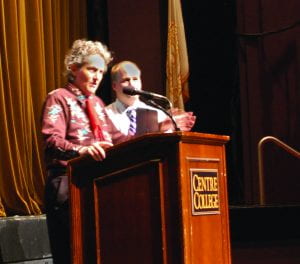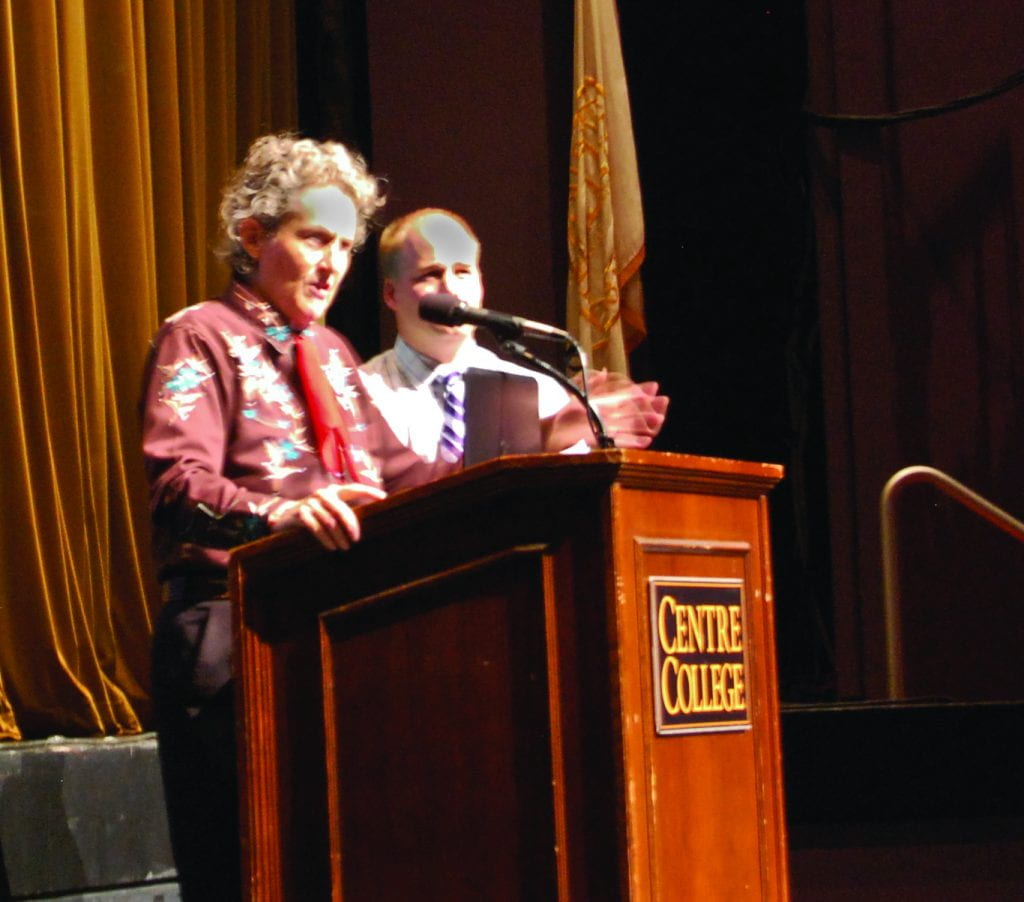By HAYLEY HOFFMAN – STAFF WRITER
On Thurs., Sept. 12, students and faculty gathered to listen to the first-year book author Temple Grandin speak about her autobiography Thinking in Pictures.
Grandin is an autism activist and serves as a consultant to the livestock industry about animal behavior in slaughterhouses.
She is a professor of Animal Sciences at Colorado State University and the author of several bestselling books, including The Way I See It and The Autistic Brain. She was also the subject of the HBO film Temple Grandin, which received multiple Emmy Awards in 2010.
Grandin began her speech by giving an introduction to autism and the spectrum on which it operates.
“If you have a little bit of the autistic trait, you’ll have an advantage,” Grandin said. “If you have too much of the trait, you’ll have a handicap.”
She then drew on examples of several autistic children, like Albert Einstein and Steve Jobs, who overcame their handicaps to become successful later in life. This, Grandin claimed, was due to the help they received from their peers and teachers while in school.

“When you’re different and not that social,” Grandin said, “You need to get involved with other people that have shared interests.”
Throughout her speech, Grandin spoke of her own mentors who helped her to achieve even though the odds were against her. They encouraged her to develop and pursue her interests in animals and technology, which ultimately set her on the path to revolutionizing the livestock industry.
Grandin addressed the problems she sees in the modern educational system for diagnosing and educating children on the autism spectrum. “The education system fails to stimulate and educate visual learners,” Grandin said. “These kids need to be stretched and need mentors to teach them skills to use in the workplace.”
Grandin was thrilled to be asked to come to Centre’s campus. “I’m honored to be here and I’m excited that my book was chosen for incoming students to read,” Grandin said.
Thinking in Pictures is about Grandin’s life as a person living with autism. In it, she shares how she overcame her difficulties to function in society by thinking in an unusual way.
“My thinking is bottom-up,” Grandin said. “I form a concept with specific examples. I don’t go to the theory first and then try to shove the details in.”
These examples are then separated into categories, which are organized by common visual features. Grandin is able to use this way of thinking to create detailed blueprints from memory.
First-year Caitlin Smith enjoyed reading the book this summer. “I like psychology, so it was interesting to see how Grandin thinks versus how I think,” Smith said.
Sophomore Sanna Gough was interested in Grandin’s methods.
“The convocation was very interesting because of the ways that Grandin suggested we educate autistic children. She is living proof that those methods will work and help those kids succeed.”
At the convocation, first-year Emilie O’Connor asked Grandin if she thought her life would have different had she never been told of her autism diagnosis.
“I was a child with no speech,” Grandin said. “I was the kind of child they would put in the mental hospital. If I had only been diagnosed with speech delay, they would have sent me to a speech therapist and a therapy school.”
Grandin stressed the importance of communities coming together and using their resources to help children with autism. Without the community, the “quirky kids” would have no outlet and no mentors to help them succeed.
Grandin’s closing thought for the group was about not stressing to a child that they are “just autistic.” People on the autism spectrum have jobs and contribute to their community, just like “normal” people; in other words, they’re more than just a label.
“Autism is not my whole sense of being,” Grandin said. “But, it’s part of who I am, and I wouldn’t want to change it.”
